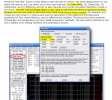- Thread Starter
- #21
As the Purifi blog post (link: https://purifi-audio.com/2019/12/10/a-fast-driver-needs-a-light-cone-or-does-it/) pointed out, the sound wave generated by the speaker driver is NOT the result of a positional change (displacement) of the diaphragm, NOR its velocity, but its acceleration. This is the primary misconception.There is not such a thing as a "faster" driver, and there never will be.
Everyone with an engineering background knows control theory and mass-spring-damper constructions.
(or they should it's part of any curriculum starting mostly from the 2nd year or so)
More mass simply means that something takes more force to accelerate at the same amount.
Or in other words, with the same force, things will accelerate less.
Things resist when they are heavy (you know, Newton)
For loudspeakers and 2nd (and higher) order mass-spring-damper systems, this results in that the frequency response collapses.
In practice the inductance is more dominant with most subwoofers, so this is what most people see.
Unless a proper amount of demodulation rings is being used.
On the lower frequencies below Fs, mass is a constant and the compliance is the dominant factor.
There is something else called a Q-factor, which doesn't have much to the with the mass perse.
Depending if it is under-damped, criticality damped or overly-damped, this automatically translates to an hump in the frequency response.
Or like max flat frequency response etc
The effect of a lower mass diaphragm is, as @dshreter pointed out earlier, is higher sensitivity (efficiency). If we define the "speaker speed" as how quickly a sound wave shows up, then it is determined by how quickly we can apply a force change to the diaphragm. And how fast we can change the force is largely* independent of the moving mass of the diaphragm.
*Note: By largely I mean this can depend on the voice coil design, which will affect mass, but is a secondary or less effect.


